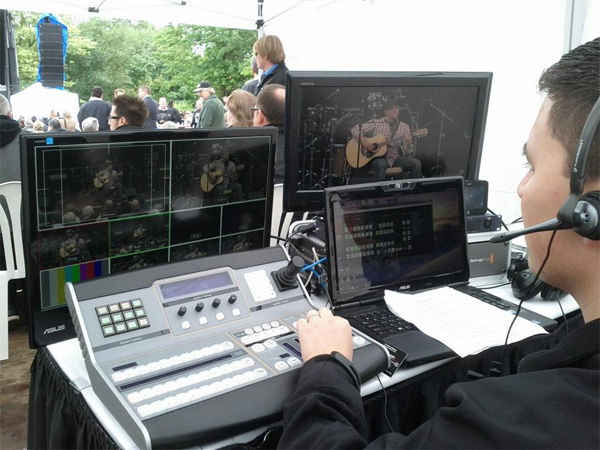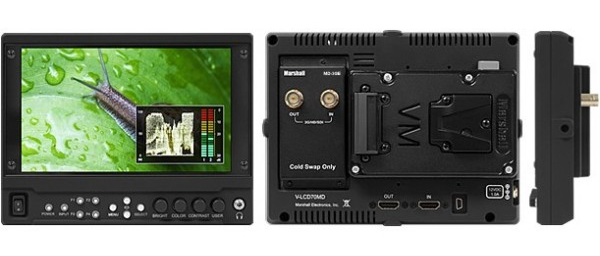HD Field Recorders for Live Production--UPDATED!
Now featuring a new interview from NAB 2013 on the Sound Devices Pix240i, this article looks at a handful of portable and rackmount external video recorders for live HD production, specifically in the role of recording the master program feed from a live switch.
Audio Capabilities and I/O
Audio is where video recording gets complicated. The absence of adequate audio capabilities is an unfortunate oversight and ultimately is why I don’t love any of the available external recorder solutions discussed here. If the audio is embedded in the HD-SDI (or HDMI) signal, then it gets passed along on the same video input cable. Embedding audio in the HD-SDI is usually accomplished by either connecting the sound board XLR output to a connected video camera or--better yet--the video switcher, provided it has audio inputs.
The other audio input option is an analog connection--either XLR or a headphone jack input. I prefer an XLR connection, mainly because it locks in but also because it is a balanced connection. Often I often don’t sit right next to the audio console, so cable length is a consideration as well. Portable recorders lack XLR inputs, mainly for size reasons.
Having the camera operator handle the recording audio levels isn’t the workflow I want to use, especially as I want their ears to be focused on my intercom feed to them and not listening to the program audio from a soundboard. However, in some cases individual camera operators, with their limited VU meters and headphone outputs, are better equipped to handle this monitoring than the video switcher operator if they don’t have the required additional equipment.
Monitoring audio from portable recorders is easy, as most provide a headphone jack, but unfortunately most rackmount units lack a basic headphone jack and rely on audio level displays--some better than others--as their sole audio monitoring tool. This is a major oversight. You need to hear the audio feed to listen for pops, hiss, clicks, interference, dropouts, and noise in general. A VU meter can’t tell you how clean your audio is and needs to be used in tandem with listening to the program audio with a good set of headphones. Unfortunately, some units that have headphone jacks lack a proper VU meter display and rely on small audio level meters. In general, no one external recorder has a headphone jack, video display, and proper VU meters.
Video Mixer Audio
I use my Blackmagic Design ATEM 1 M/E (Figure 5, below) as the primary XLR audio input point from the soundboard. Its software control panel offers me the ability to mix different line level inputs and to embed my audio mix in the HDMI or HD-SDI outputs, as well as provide a pair of XLR audio outputs. The visual audio level monitoring is great but like too many of the recorders, it lacks a headphone output, either from the computer or the video switcher panel.

Figure 5. The Blackmagic Design ATEM 1 M/E switcher
My solution for both the video switcher and external recorder audio and video monitoring is to use a Marshal V-LCD70MD-3G 7” HD monitor (Figure 6, below). I like this specific monitor because it has a high-resolution 1024x600 LED Backlit IPS panel that is way higher resolution than the video monitors on any external recorder. It also has a proper VU meter that I can overlay on the screen and a headphone output that I can use to actually listen to the audio.

Figure 6. The Marshal V-LCD70MD-3G HD monitor
As much as I love my ATEM 1 M/E for its rackmount form factor, price, and versatility, I have to admit I also love the VU meters and headphone output on the Sony MCS8M video and audio mixing switcher.
Recording Options
If you use a video camera with a clean, high signal-to-noise ratio output, you don’t always need an extremely high-bitrate uncompressed or intrafame codec recording. Some users will appreciate high-bitrate features but recording the archive from a corporate webcast or a conference doesn’t normally warrant the extra initial effort, higher-specification recording media, and storage cost. I prefer to use recorders with a 100Mbps recording option of ProRes LT, which is already 4x larger than what my camera can record internally. By comparison, ProRes HQ is a 250Mbps codec and overkill for all of the live non-greenscreen work that I do. Avid users will appreciate recorders that offer DNxHD recording options.
In addition to requiring more storage space, more time to transfer, and faster hard drive RAIDs for video editing, higher-bitrate codecs require faster and more expensive recording media. Some of this is only a factor of spending a bit more money on a more powerful video editing workstation, but if you are a client and you want to watch the footage on your laptop, you will appreciate a bitrate that doesn’t exceed what your laptop hard drive can power.
Related Articles
Whether you're an independent production facility or a corporate or institutional outfit bringing professional online video production and webcasting in-house, what will it cost to create a flexible and functional studio? In this article, we'll spec out three different studios at three different price points—$5,000, $15,000, and $25,000.
Spend a little or spend a lot -- there's a tremendous price range -- but be sure to ask these questions before you buy a production switcher.
It's all about finding the right technologies and creating the best workflow, especially when streaming live video.
The ATEM Television Studio is a software-driven video and audio mixer that, for less than $1000 (US), allows you to mix up to six cameras down into a single output program feed, live. You can also add keys, masks, and titles, and it features a built-in H.264 encoder that puts this little stick of tricks firmly on the webcaster's radar.
This article is the fourth in a series on webcast video production and discusses video switchers, including the cost and features that differentiate several popular models.
DVEO HD Spigot converters feature dual outputs and are fully compatible with SMPTE-259M and SMPTE 292M; supported resolutions include 1080p, 1080i, 1035i, or 720p HD
Part 2 of this series on webcast video production focuses on Sony's NEX-FS100 large-sensor camcorder and new capabilities added via a firmware upgrade that (among other things) makes it compatible with Sony's LA-EA2 lens adapter. While it's not as strong a webcast camera as the FS700 (review coming soon), it still has much to recommend it.
This article will be the first in a series of articles on webcasting and will cover a wide range of topics including video cameras, video switchers, converters, computer inputs, audio, reference monitors, webcast hardware, webcast software, live streaming services providers, and some additional hardware that is important in order to produce a professional live webcast.
In Episode 2, Shawn discusses the MC100, the new SDI-to-HDMI mini converter from Matrox Video with Matrox product manager Charles Amyot.